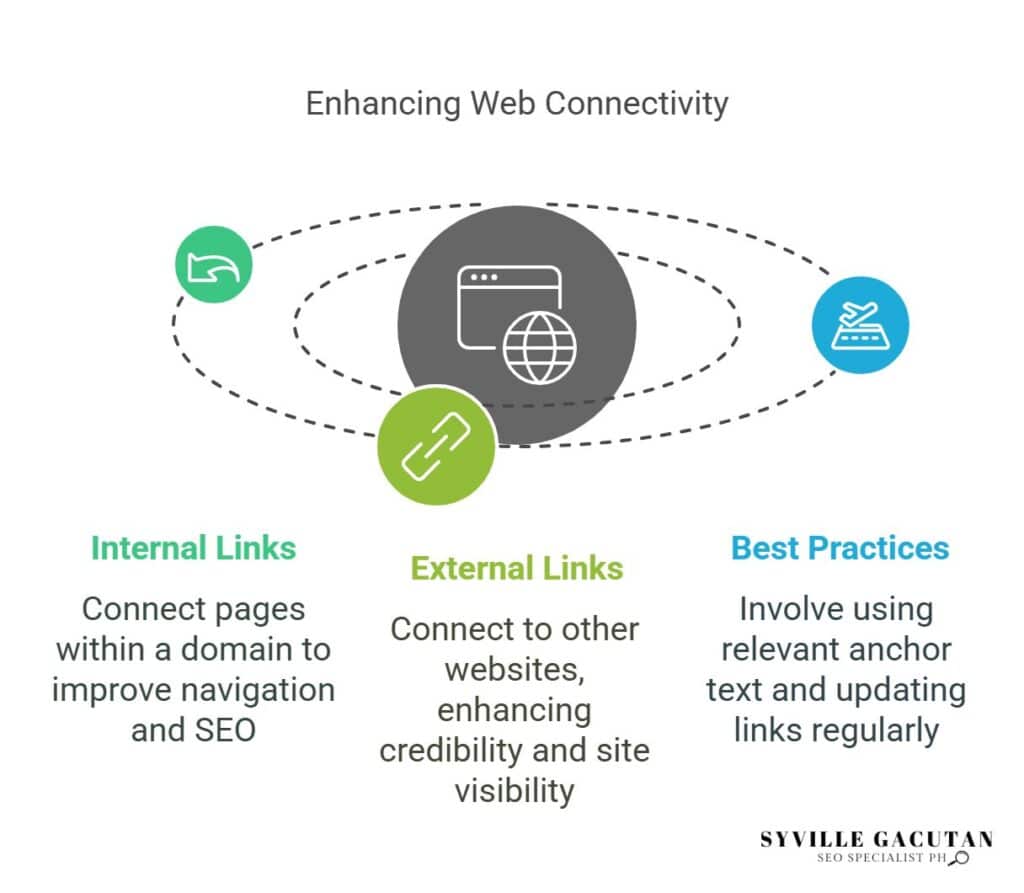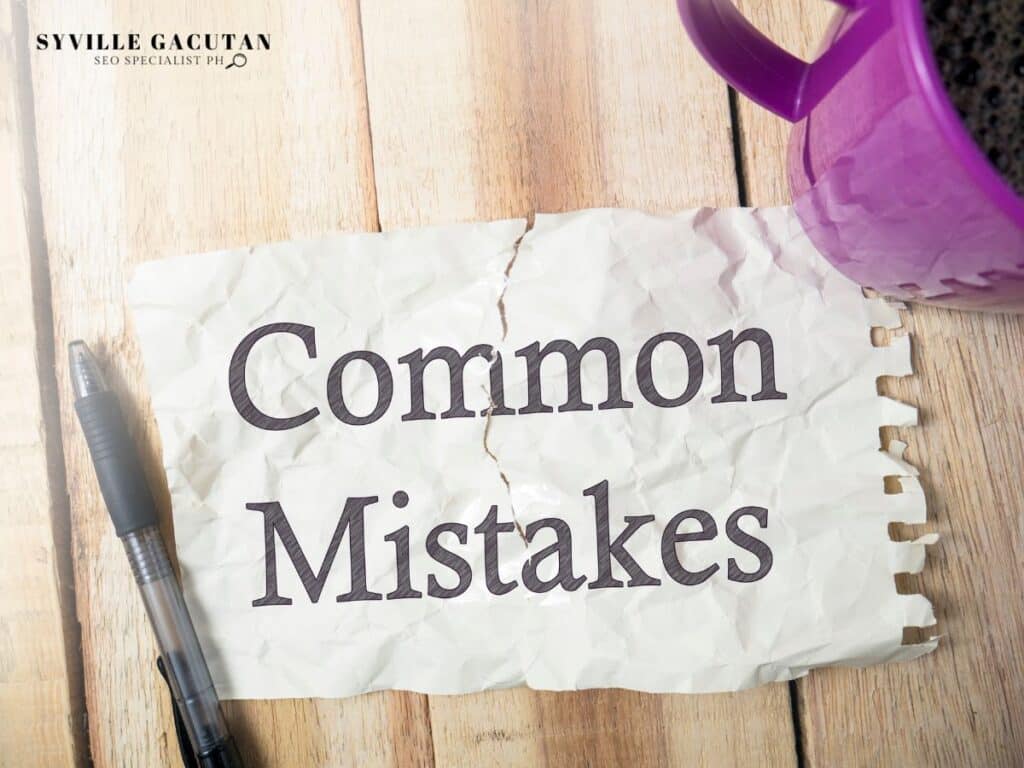
Internal links connect pages within the same domain, guiding users and search engines through a website’s internal structure. Links make it easier to move around. They spread importance across pages. Links aid search engine optimization efforts. Relevant connections keep users interested. External links, on the other hand, connect to pages on different websites. They enhance a website’s trustworthiness. Also, they elevate search engine rankings by connecting with reputable sources thereby broadening the site’s reach. While internal links strengthen the site’s internal coherence, external links enhance its authority and reputation within a broader digital ecosystem. For those interested in maximizing their website’s potential, understanding these link types becomes essential.
Key Takeaways
- Internal links connect pages within a domain, enhancing navigation and distributing page authority effectively.
- External links connect to other websites, enhancing credibility and enriching content by associating with reputable sources.
- Internal links improve website crawlability and support SEO by guiding users to relevant content.
- External links serve as a ranking factor, enhancing site visibility and reputation through connections with authoritative sites.
- Best linking practices include using relevant anchor text and regularly updating links to maintain user experience and SEO benefits.

Understanding Internal Links
Understanding internal links is crucial for effective website navigation and optimization. These links are the connections between different pages within the same domain, forming a cohesive structure that guides both users and search engines through the content. Internal links are links that not only facilitate seamless navigation for users but also play a vital role in enhancing a website’s SEO performance. Web pages organize data in a structured manner. This arrangement aids search engines in comprehending the significance & context of each individual page.
Utilizing internal links strategically can significantly influence the distribution of “link juice” across your site, which is the equity or value passed from one page to another through hyperlinks. This distribution can enhance the visibility of important pages, encouraging search engines to prioritize them when indexing content. By effectively building internal links, webmasters can ensure that crucial pages receive the attention they deserve, thus improving their ranking potential.
Moreover, internal links help in maintaining user engagement by providing pathways to related content, which can increase the time spent on the site and reduce bounce rates. This user-centric approach not only enriches the browsing experience but also signals to search engines that the site offers valuable content, further boosting its search performance.
Understanding External Links
While internal links enrich the user experience and enhance SEO by connecting pages within a single domain, external links extend a website’s reach beyond its own boundaries. These links direct users from one website to another, creating a bridge to new sources of information. Understanding external links is crucial for webmasters and content creators aiming to boost their site’s credibility and authority in the digital landscape.
External links are important for several reasons. They signal to search engines that a site is connected to a broader network of online content, which can enhance its visibility. By linking to trustworthy and informative content, a website demonstrates its commitment to providing valuable resources to its audience. This, in turn, can improve the site’s standing in search engine optimization (SEO) rankings, as search engines often prioritize sites that connect users to authoritative sites.
Moreover, external links can enhance a site’s reputation by associating it with well-regarded sources, thereby instilling confidence in its audience. When users encounter links directing them to authoritative sites, they are more likely to perceive the initial site as credible and knowledgeable. This perceived credibility can lead to increased user engagement and retention, as visitors are more inclined to return to a site they trust.
Internal Link Benefits

How do internal links contribute to a site’s overall SEO strategy? Internal links play a crucial role in enhancing a website’s SEO by connecting various pages within the same domain. They create a network-like structure that guides users and search engines through the site. This interconnectedness is pivotal for several reasons, making internal linking an indispensable part of any SEO strategy.
- Improved Crawlability: Internal links connect different pages, enabling search engines to crawl and index them more efficiently. This ensures that all pages, especially the important pages, are discovered and ranked accordingly.
- Enhanced User Experience: By guiding users to relevant content, internal links help in maintaining the flow of information and engagement. This not only keeps visitors on the site longer but also increases the likelihood of conversions.
- Page Authority Distribution: Internal links distribute page authority throughout the site. Linking to important pages can help transfer some of the authority from high-ranking pages, ensuring that crucial content receives the visibility it deserves.
- Keyword Strategy Support: By strategically placing internal links with anchor text containing relevant keywords, a site can reinforce its keyword strategy. This helps search engines understand the content’s focus, potentially boosting rankings for targeted keywords.
In essence, internal link benefits extend beyond mere navigation. They provide a structured pathway for users and search engines alike, ensuring that a site’s content is accessible, relevant, and ranked appropriately.
Thus, internal links are not just connectors within a site; they are instrumental in the broader SEO framework, ensuring that a site’s most important pages receive the attention they merit.
External Link Benefits

In addition to the advantages of internal links, external links also play a significant role in the broader SEO strategy. While internal links guide users within a specific website, external links serve as bridges to other web domains, offering a plethora of benefits that enhance a site’s visibility and authority.
External links may significantly contribute to a website’s search engine optimization by connecting it to relevant, authoritative sources. This connection is crucial as it signals to search engines that the linked content is trustworthy and authoritative, thus potentially improving the site’s credibility.
Valuable external links are those that direct users to high-quality, relevant content. By associating a website with these trusted sources, a site can enhance its own reputation in the eyes of search engines. The presence of such links indicates that the website is part of a broader, informative network, thereby increasing its likelihood of being ranked higher in search results.
This strategic use of external links can also help search engines crawl and index content more efficiently, facilitating better discovery and indexing of web pages.
Furthermore, external links may drive traffic from other sites, introducing new visitors to the website. This influx can lead to increased engagement and potential conversions, as visitors discover valuable content.
How Internal Links Work

Navigating a website effectively hinges on the strategic implementation of internal links. These links, which connect different web pages within the same domain, play a crucial role in guiding users through content and enhancing the overall user experience. Internal links lead visitors to relevant and related information, ensuring they can easily find what they are looking for.
Moreover, well-placed links on your website can significantly aid in the seamless flow of information, contributing to higher engagement and lower bounce rates.
The effectiveness of internal links is largely dependent on how they are structured and utilized. Here are four key components to consider:
- Anchor Text: The clickable text in a hyperlink should be descriptive and relevant to the target page. This not only helps users understand where the link will lead them but also aids search engines in indexing your content effectively.
- Link Placement: Positioning links pointing to related content within the body of your text can enhance user engagement. This encourages users to explore more pages on your website, increasing dwell time and providing deeper insights into your offerings.
- Hierarchy and Structure: Organizing your web pages in a hierarchical manner, with internal links reflecting this structure, ensures that users and search engines can navigate and index your site efficiently.
- Relevance: Ensure that the links are contextually relevant to the content on the page. Irrelevant links can confuse users and dilute the value of your content.
Ultimately, internal links are vital for optimizing the user journey and improving the accessibility of your website’s content. By focusing on these elements, you can create a more intuitive and engaging online experience.
How External Links Work

Understanding the mechanics of external links is essential for leveraging their benefits in enhancing both user experience and search engine optimization. External links are links that direct users from one website to a different domain. These links play a pivotal role in the digital ecosystem by connecting different web resources, thus providing users with valuable and diverse information.
When you use external links strategically, you create pathways that can improve the credibility and relevance of your content in the eyes of search engines like Google.
From a search engine optimization perspective, external links can be divided into two main categories: outbound and inbound links. Outbound links are those that direct traffic from your site to another, while inbound links, also known as backlinks, are links from other domains pointing to your site.
Having high-quality inbound links to your site is often viewed as a vote of confidence by search engines, as it suggests that your content is valuable and trustworthy.
Search engines like Google utilize external links as one of many factors in their ranking algorithms. The presence of credible and relevant inbound links can enhance your site’s authority, leading to improved visibility in search results.
Conversely, thoughtfully chosen outbound links can enrich your content by providing users with additional context or supporting information.
Common Internal Link Mistakes

Although internal links play a crucial role in website navigation and SEO, common mistakes in their implementation can undermine their effectiveness. Properly structured internal linking can enhance the user experience and improve your site’s ranking power by effectively distributing link equity across various pages. However, errors in this process can lead to missed opportunities.
- Overuse of Internal Links: One of the most frequent common internal link mistakes is the excessive or indiscriminate use of links on your site. This can overwhelm users and dilute the link value that is passed between pages, reducing the overall effectiveness of internal and external linking strategies.
- Broken Links: Links that lead to non-existent pages or generate 404 errors can be detrimental to both user experience and SEO. Regularly auditing your site to ensure that all links are functioning as intended is crucial to maintaining their effectiveness.
- Irrelevant Linking: Internal links should be contextually relevant and add value to the user journey. Linking to unrelated content can confuse users and disrupt the flow of navigation, potentially harming your site’s credibility and ranking power.
- Neglecting Anchor Text: Anchor text should be descriptive and relevant, providing users with a clear understanding of what they can expect when clicking the link. Using generic phrases like “click here” fails to convey meaningful context and can negatively impact SEO.
Common External Link Mistakes

While internal linking is pivotal for optimizing website navigation and SEO, external linking also holds significant influence over a site’s authority and relevance in the digital landscape. However, improper use of external links can detract from a website’s credibility and user experience.
One common mistake is linking to irrelevant or low-quality content. Unlike internal links, which guide users within a site, external links should connect to reputable sources that enhance the topic being discussed. Linking to content that lacks relevance or credibility can diminish trust and adversely affect search engine rankings.
Another prevalent error is overlinking. Including an excessive number of external links on a webpage can overwhelm users and dilute the content’s focus. Just as with internal links, moderation is key to maintaining a balanced and engaging user experience. Moreover, overlinking might be perceived as spammy by search engines, potentially impacting the site’s authority negatively.
Failing to regularly check and update external links is another oversight. Dead or broken links can frustrate users and harm the website’s reputation. Regularly auditing and maintaining these links ensures that they continue to offer relevant content and value to visitors.
Lastly, not leveraging the potential of backlinks from external sites can be a missed opportunity. While internal links help in page navigation, external links from authoritative sites can boost a site’s credibility and search engine positioning.
Building quality backlinks requires strategic outreach and relationship building, aiming to enhance the site’s authority within its niche. By avoiding these common mistakes, businesses can effectively harness the power of external links to enhance both user experience and site authority.
Final Thoughts
Internal and external links serve distinct but complementary roles in SEO and user experience. Internal links enhance website navigation and SEO by guiding users and search engines within your domain, while external links improve your site’s credibility and authority by connecting to reputable external sources. Both types of links are integral to a well-rounded SEO strategy, with internal links supporting site structure and user engagement, and external links bolstering a site’s reputation and reach. Balancing both internal and external links, using relevant anchor text, and regularly updating them ensures a seamless and optimized browsing experience.
Want to optimize your website with a perfect balance of internal and external links? Connect with Syville Gacutan, an experienced SEO Specialist in the Philippines. Syville can help you enhance your site’s SEO performance and user experience through strategic linking practices. Contact today to elevate your website’s visibility and credibility!